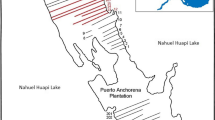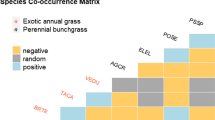Abstract
We reconstructed the invasion of a non-native tree (hawthorn, Crataegus monogyna) into fire-induced grassland in montane South Island, New Zealand. Using the relationship between height and age to reconstruct the rate of increase of the population, we identified three distinct invasion phases. We hypothesised that these related to the abundance of woody vegetation and therefore of non-native blackbirds (Turdus merula), the primary disperser of hawthorn in this environment. From the 1930s to 1959, increase was relatively slow, with hawthorn spread probably constrained due to browsing of seedlings by European rabbits (Oryctolagus cuniculus) and the low abundance of a native N-fixing shrub (matagouri, Discaria toumatou) providing few perches and nesting sites for blackbirds and safe sites for hawthorn establishment. Subsequently, from 1959 to 1976, hawthorn showed greater than six fold acceleration in its rate of population increase, resulting largely from intensive rabbit control, less frequent fires, and aerial topdressing of phosphate fertilizer promoting the growth of matagouri scrub. In addition, maturing hawthorn trees provided additional food and nesting sites for blackbirds. Hawthorn population increase slowed again from 1976, possibly because most suitable habitat in the immediate vicinity of the population neared saturation. From this case study we have constructed a general hypothesis for the factors determining the rate of invasion of matagouri—grassland habitats by bird-dispersed non-native woody plants in montane New Zealand.






Similar content being viewed by others
References
Andow DA, Kareiva PM, Levin SA, Okubo A (1990) An investigation of the invasive European buckthorn, Rhamnus cathartica L., near Saskatoon, Sascatchewan. Can Field-Nat 111:617–621
Bascand LD, Jowett GH (1981) Scrubweed cover of South Island agricultural and pastoral land. N Z J Exp Agric 9:307–327
Bascand LD, Jowett GH (1982) Scrubweed cover of South Island agricultural and pastoral land 2. Plant distribution and managerial problem status. N Z J Exp Agric 10:455–492
Bass DA (1990) Dispersal of the introduced shrub (Crataegus monogyna) by the brushtailed possum (Trichosurus vulpecula). Aust J Ecol 15:227–229
Bellingham PJ (1998) Shrub succession and invasibility in a New Zealand montane grassland. Aust J Ecol 23:562–573
Bellingham P, Coomes D (2003) Grazing and community structure as determinants of invasion by Scotch broom in a New Zealand montane shrubland. Divers Distrib 9:19–28
Bull PC (1969) The small placental mammals. In: Knox GA (ed) The natural history of Canterbury. Reed, Wellington, pp 400–417
Cheeseman TF (1925) Manual of the New Zealand Flora. Government Printer, Wellington
Courtney SP, Manzur MI (1985) Fruiting fitness in Crataegus monogyna: the effects of frugivours and seed predators. Oikos 44:398–406
Cousens R, Mortimer M (1995) Dynamics of weed populations. Cambridge University Press, Cambridge
Daly GT (1969) The biology of matagouri. Proc N Z Weed Pest Control Conf 22:195–200
Davidson M (1969) The larger wild mammals. In: Knox GA (ed) The natural history of Canterbury. Reed, Wellington, pp 418–425
Deckers B, Verheyen K, Vanhellemont M, Maddens E, Muys B, Hermy M (2008) Impact of avian frugivores on dispersal and recruitment of the invasive Prunus serotina in an agricultural landscape. Biol Invasion 10:717–727
Dietz H, Edwards PJ (2006) Recognition of changing processes during plant invasions may help reconcile conflicting evidence of the causes. Ecology 87:1359–1367
Frappier B, Lee TD, Olson KF, Eckert RT (2003) Small-scale invasion pattern, spread rate, and lag-phase behavior of Rhamnus frangula L. For Ecol Manag 186:1–6
Garcia D, Obeso JR, Martinez I (2005) Spatial concordance between seed rain and seedling establishment in bird-dispersed trees: does scale matter? J Ecol 93:693–704
Genstat Committee (2007) Genstat 10 Reference Manual. Clarendon Press, Oxford
Good JEG, Bryant R, Carlill P (1990) Distribution, longevity and survival of upland hawthorn (Crataegus monogyna) scrub in North Wales in relation to sheep grazing. J Appl Ecol 27:272–283
Groves RH (2006) Are some weeds sleeping? Some concepts and reasons. Euphytica 148:111–120
Grubb PJ, Lee WG, Kollmann J, Wilson JB (1996) Interaction of irradiance and soil nutrient supply on growth of seedlings of ten European tall-shrub species and Fagus sylvatica. J Ecol 84:827–840
Guitian J, Fuentes M (1992) Reproductive biology of Crataegus monogyna in northwestern Spain. Acta Oecol 13:3–11
Herrera CM (1984) A study of avian frugivoures, bird-dispersed plants, and their interaction in Mediterranean shrublands. Ecol Monogr 54:1–23
Hulme PE (1997) Post-dispersal seed predation and the establishment of vertebrate dispersed plants in Mediterranean scrublands. Oecologia 111:91–98
Jordano P, Schupp EW (2000) Determinants of seed dispersal effectiveness: the quantity component in the Prunus mahaleb–frugivorous bird interaction. Ecol Monogr 70:591–615
Kollmann J, Grubb PJ (1999) Recruitment of fleshy-fruited species under different shrub species: control by under-canopy environment. Ecol Res 14:9–21
Kollmann J, Coomes DA, White SM (1998) Consistencies in post-dispersal seed predation of temperate fleshy-fruited species among seasons, years and sites. Funct Ecol 12:683–690
Ludvigi A, Vanicsek L, Torok J, Csorgo T (1995) The effect of nest-height on the seasonal pattern of breeding success in blackbirds Turdus merula. Ardea 83:411–418
McDonnell MJ (1986) Old field vegetation height and the dispersal of bird-disseminated woody plants. Bull Torrey Bot Club 113:6–11
Milton SJ, Wilson RU, Richardson DM, Seymour CL, Dean WRJ, Iponga DM, Prochet S (2007) Invasive alien plants infiltrate bird-mediated shrub nucleation processes in arid savanna. J Ecol 95:648–661
Moar N (2008) Late quarternary vegetation. In: Winterbourn M, Knox G, Burrows C, Marsden I (eds) The natural history of Canterbury, 3rd edn. Canterbury University Press, Christchurch, pp 169–192
Molloy BPJ (1976) An analysis of sweet brier on Molesworth. Appendix B. In: Moore LB (ed) The changing vegetation of Molesworth station, New Zealand, 1944 to 1971. New Zealand Department of Scientific and Industrial Research Bulletin No. 217
Molloy BPJ, Burrows CJ, Cox JE, Johnston JA, Wardle P (1963) Distribution of subfossil forest remains, eastern South Island, New Zealand. N Z J Bot 1:68–77
Moore LB (1976) The changing vegetation of Molesworth station, New Zealand, 1944 to 1971. New Zealand Department of Scientific and Industrial Research Bulletin No. 217
O’Connor KF (1981) Changes in the tussock grassland and mountain lands. Tussock Grassl Mt Land Inst Rev 40:47–61
Parker IM, Simberloff D, Lonsdale WM, Goodell K, Wonham M, Kareiva PM, Williamson MH, Von Holle B, Moyle PB, Byers JE, Goldwasser L (1999) Impact: toward a framework for understanding the ecological effects of invaders. Biol Invasions 1:3–19
Pimentel D (2002) Environmental and economic costs of alien plant, Animal and Microbe Invasions. CRC Press, Florida
Pyšek P, Hulme PE (2005) Spatio-temporal dynamics of plant invasions: linking pattern to process. Ecoscience 12:302–315
Sakai AK, Allendorf FW, Holt JS, Lodge DM, Molofsky J, With KA, Baughman S, Cabin RJ, Cohen JE, Ellstrand NC, McCauley DE, O’Neil P, Parker IM, Thompson JN, Weller SG (2001) The population biology of invasive species. Annu Rev Ecol Syst 32:305–332
Sallabanks R (1992) Fruit fate, frugivory, and fruit characteristics: a study of the hawthorn, Crataegus monogyna (Rosaceae). Oecologia 91:296–304
Schmidt KA, Whelan CJ (1999) Effects of exotic Lonicera and Rhamnus on songbird nest predation. Conserv Biol 13:1502–1506
Schofield RC (1954) Scrub weeds of Central Otago. Proceedings of the NZ weed control conference 7:86–88
Silander JA, Klepeis DM (1999) The invasion ecology of Japanese barberry (Berberis thunbergiii) in the New England landscape. Biol Invasions 1:189–201
Simberloff D, Holle BV (1999) Positive interactions of nonindigenous species: invasional meltdown? Biol Invasions 1:23–32
Smith VH (1992) Effects of nitrogen: phosphorus supply ratios on nitrogen fixation in agricultural and pastoral ecosystems. Biogeochemistry 18:19–35
Snow B, Snow D (1988) Birds and berries. T and AD Poyser, Carlton
Sullivan JJ, Williams PA., Timmins SM, Smale MC (2009) The distribution and spread of environmental weeds along New Zealand roadsides. N Z J Ecol 33 (In Press)
Thomas AS (1960) Changes in vegetation since the advent of myxomatosis. J Ecol 48:287–306
Timmins SM, Williams PA (1987) Characteristics of problem weeds in New Zealand’s protected natural areas. In: Saunder DA, Arnold G, Burbidge AA, Hopkins AJM (eds) Nature conservation: the role of remnants of native vegetation. Surrey Beatty in association with CSIRO and CALM. pp 241–247
Van Heezik Y, Ludwig K, Whitwell S, McLean IG (2008) Nest survival of birds in an urban environment in New Zealand. N Z J Ecol 32:155–165
Vitousek PM, Walker LR (1989) Biological invasion by Myrica faya in Hawaii: plant demography, nitrogen fixation, ecosystem effects. Ecol Monogr 59:247–265
Wangen SR, Webster CR (2006) Potential for multiple lag phases during biotic invasions: reconstructing an invasion of the exotic tree Acer platanoides. J Appl Ecol 43:258–268
Wardle P (1991) Vegetation of New Zealand. Cambridge University Press, Cambridge
Webb CJ, Sykes WR, Garnock-Jones PJ (1988) Flora of New Zealand, vol IV. Naturalised pteridophytes, gymnosperms, dicotyledons. Botany Division, Department of Scientific and Industrial Research, Christchurch, p 1365
Williams PA (2006) The role of blackbirds (Turdus merula) in weed invasion in New Zealand. N Z J Ecol 30:285–291
Williams PA, Buxton RP (1986) Hawthorn (Crataegus monogyna) populations in mid-Canterbury. N Z J Ecol 9:11–17
Williams PA, Karl BJ (1996) Fleshy fruits of indigenous and adventive plants in the diet of birds in forest remnants, Nelson, New Zealand. N Z J Ecol 20:127–145
Williams PA, Timmins SM (2002) Economic impacts of weeds in New Zealand: some examples. In: Pimentel D (ed) Environmental and economic costs of alien plant, animal and microbe invasions. CRC Press, Boca Raton, pp 175–184
Williams PA, Karl BJ, Bannister P, Lee WG (2000) Small mammals as potential seed dispersers in New Zealand. Aust Ecol 25:523–532
Acknowledgments
We thank Brian Karl for field assistance, Stephen Ferris for GIS assistance, Richard Duncan for statistical advice and Graeme Bourdôt and especially Peter Bellingham for helpful discussions. Two referees made valuable contributions to the paper. Figure 3 map background sourced from Topographic Map Series 260, Crown Copyright Reserved. This work was funded by New Zealand Foundation for Research Science and Technology through programmes C09X0502 and C09X0504.
Author information
Authors and Affiliations
Corresponding author
Rights and permissions
About this article
Cite this article
Williams, P.A., Kean, J.M. & Buxton, R.P. Multiple factors determine the rate of increase of an invading non-native tree in New Zealand. Biol Invasions 12, 1377–1388 (2010). https://doi.org/10.1007/s10530-009-9554-9
Received:
Accepted:
Published:
Issue Date:
DOI: https://doi.org/10.1007/s10530-009-9554-9




